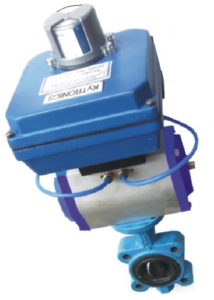
Pneumatic and hydraulic actuators routinely operate damper drives, flow valves, vacuum controls and other devices in countless process applications. However, there can be a sizeable performance gap between conventional open-loop positioners and closed-loop digital positioners used in such tasks. The problem, explained Ed Steutermann, president of KyTronics, Prospect, Ky., is that open-loop controllers apply a single control command. Without the benefit of feedback, the user can only assume accurate results, as there is no assurance the control effort has the desired effect.
In contrast, closed-loop controls ensure precise information continually flows in a feedback loop from the process sensor to the transmitter, controller and actuator, and back. With these positioners this “measure-decide-actuate” sequence begins the moment a controlled variable changes and doesn’t stop until the desired process condition is met, said Steutermann.
KyTronics closed-loop digital positioners control pneumatic and hydraulic rotary or linear actuators, such as cylinders or diaphragm operators. (They can also be used with electromechanical actuators.)
In pneumatic applications, for example, they use external, low-voltage solenoid valves to control airflow to the actuator. This eliminates the cams, springs, flapper valves and orifices that cause maintenance problems in conventional electropneumatic positioners. An electronic module compares controller and position signals and, in the event of a mismatch, opens the solenoid valve to supply flow and quickly move the actuator to the setpoint position. This results in reliable performance because the actuator shaft always moves to the same position in response to the same signal, not to a force-balance position as in conventional positioners. Thus, KyTronics positioners are unaffected by adverse conditions such as “stiction” in the actuator or variation in air pressure.
Open-loop positioners, on the other hand, are essentially proportional controllers where a slide valve opens in proportion to a signal change. Actuator movement doesn’t begin until sufficient air bleeds into the actuator to reach the breakaway force. This can lead to noticeable delays, controller signal ramping, overshoot and oscillation—all of which can hurt system performance.
The ability to quickly attain and lock at the specified position also holds an advantage in hydraulic applications. That’s because the positioner prevents actuator shaft movement despite dynamic changes (usually pressure) due to fluid flowing in the system. On the other hand, conventional positioners may let valve position deviate from intended in response to external forces.
A key feedback element is the sensor. A noncontact, magnetic encoder attached to the actuator shaft provides a precise digital-position signal to control closed-loop operation, said Steutermann. The device uses discrete Hall-effect sensors in an array on an encoder board. A magnetic sweep arm responds to shaft motion and moves over the array to generate a unique binary signal for each increment of movement. The sensors are virtually immune to shock and signals do not drift due to wear or temperature, which effectively eliminates the need for recalibration in normal service. Similarly, position signals from linear transducers can be used to run devices like power cylinders.
Another benefit is that operating fluid does not enter the positioners, so dust or water does not foul operation. That differs from conventional positioners that require a continuous air bleed for operation, even when the positioner is not moving an actuator. (Bleed air is drawn from the plant compressed air header, passes through a typical positioner and exhausts to atmosphere.) That increases operating costs. In addition, such positioners have interacting electronic, mechanical and pneumatic elements. Bleed air contains entrained water, oil and dirt which can foul these elements and require maintenance.
KyTronics offers two basic positioner models. The DLA module can be remotely mounted (up to 2,000 ft from the valve) to avoid subjecting the electronics to vibration, temperature extremes and harsh or hazardous environments. The DLA displays valve position, confirmation that the actuator is operating properly, and a manual override to bypass the control signal. MCDLU modules mount on the valve with encoder and electronics housed in the same enclosure.
The positioners can directly adjust and monitor remote actuators as well as on-off valves, with or without a process controller. Stored programs provide field-selectable responses such as fail-open or closed on signal or power loss, as well as custom responses including partial spans and split ranges. Setup and calibration are reportedly quick and straightforward.
Repeatability is ±0.5%, operating temperature range -50° to 300°F and the devices require 12-24 Vdc or 120/240 Vac power.
DLA and MCDLU units have been used for more than 15 years in a variety of demanding settings. Most of the original units, said Steutermann, are still in use. DLA models are particularly suited for rugged conditions because the sensitive electronics are located out of hostile or inconvenient areas, such as in difficult-to-reach valve/damper actuator locations. Only the encoder is on the actuator. For example, several have operated hot-air dampers in a steel rolling mill at temperatures well above 100° F. The position signal transmits to a remote controller located more than 300 ft away. The DLA processor also has diagnostic capabilities to alert and pinpoint positioner or system problems. Other typical applications include use in vacuum-powered sewing and cigarette-making machines.
KyTronics Inc.
www.KyTronicsinc.com
Photo label:
MCDLU digital positioner

Leave a Reply